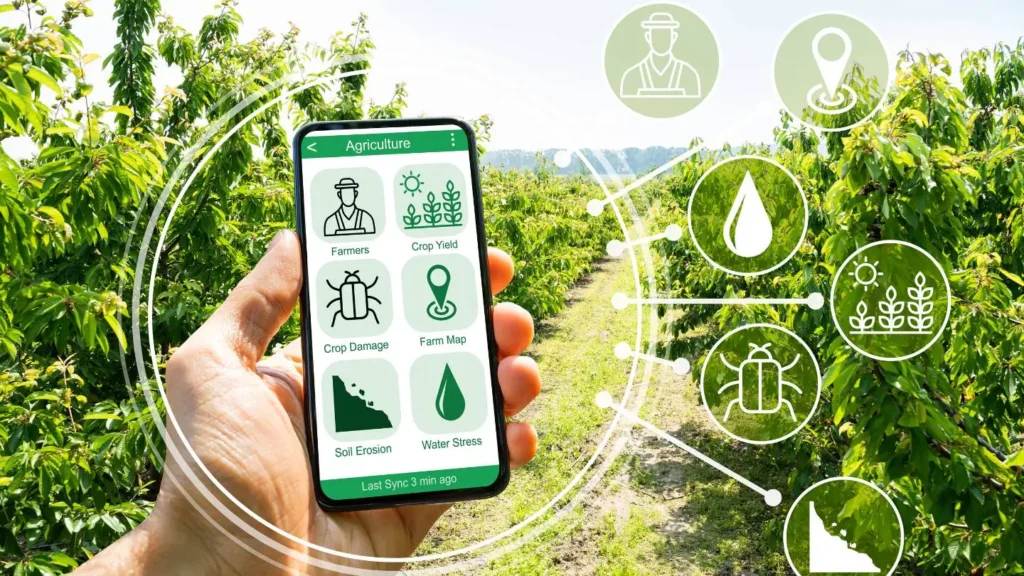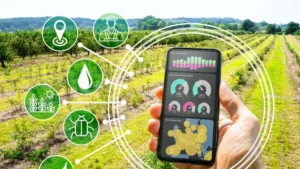Imagine a farmer’s field as a chessboard, where every square inch needs careful strategy for maximal results.
With AI, you’re not just a player but a grandmaster, making data-driven moves to maximize your harvest.
From monitoring soil health to predicting weather patterns, AI empowers you to make informed decisions, reducing costs and labor.
Yet, high initial costs and tech limitations might make you wonder if it’s worth the investment.
So, how exactly is AI transforming agriculture, and what challenges lie ahead?
Key Takeaways
- AI-driven precision agriculture maximizes yields and minimizes costs by targeting specific field areas.
- AI optimizes resource use and reduces manual labor, enhancing efficiency.
- Predictive analytics in AI forecast weather conditions for better farm management.
- AI-powered systems monitor soil health and crop conditions for informed decision-making.
- AI automation, like driverless tractors and smart irrigation, increases operational efficiency.
Benefits of AI in agriculture
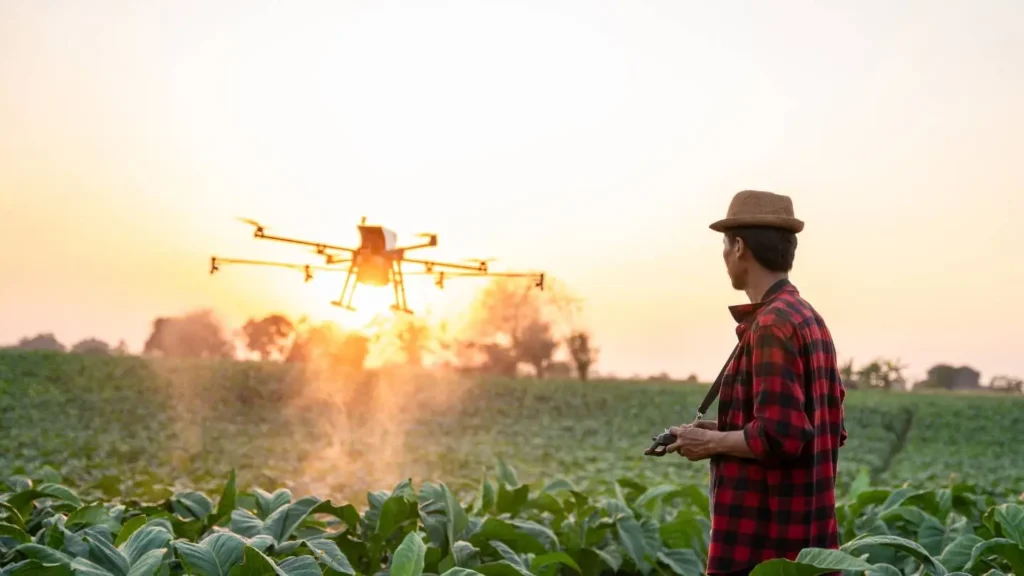

You’ll find that artificial intelligence in agriculture brings significant benefits, including cost savings, data-based decisions, and automation. By reducing manual labor and optimizing resource use, AI helps you cut expenses.
Additionally, it empowers you with precise data to make informed choices, ultimately boosting productivity and efficiency.
Cost savings
AI in agriculture slashes costs by optimizing resource use and minimizing waste. With AI-driven precision agriculture, you can identify specific areas that need irrigation, fertilization, or pest control, ensuring you’re only using resources where they’re truly needed. This targeted approach maximizes yields and minimizes costs, leading to substantial cost savings.
Vertical agriculture also benefits from AI by increasing food production while using fewer resources. By employing AI systems, vertical farms can monitor and adjust growing conditions in real-time, resulting in efficient resource utilization and reduced operational expenses. This efficiency translates into lower costs and higher profitability.
AI’s role in reducing herbicide use is another major cost-saving factor. Traditional methods often involve blanket spraying, wasting chemicals and harming the environment. With AI, you can apply herbicides precisely where needed, cutting down on chemical expenses and improving harvest quality. This targeted treatment not only saves money but also boosts your bottom line by producing healthier crops.
Incorporating AI technologies in agriculture doesn’t just enhance efficiency; it also reduces operational costs significantly. By leveraging AI, you’re not just keeping expenses in check but also setting the stage for long-term profitability and sustainability in your farming operations.
Data-based decisions
Leveraging data-based decisions, AI empowers farmers to make informed choices that optimize resource management and maximize yields. By analyzing vast amounts of data, AI helps you understand soil health, predict weather conditions, and monitor crops in real-time. This means you can make timely decisions about irrigation, fertilization, and pest control, ensuring that your resources are used efficiently.
In agriculture, the precision provided by AI can’t be overstated. It enables you to pinpoint the exact needs of different areas in your fields. For example, if a section of your land requires more water or a specific nutrient, AI will alert you, allowing for targeted interventions. This not only boosts crop health but also minimizes waste and reduces costs.
Moreover, AI’s predictive analytics can forecast weather conditions, helping you plan ahead and mitigate potential risks. Whether it’s anticipating a drought or heavy rainfall, you’ll have the insights needed to protect your crops. The decision-making process becomes more accurate, lessening the guesswork and increasing your farm’s productivity.
Ultimately, integrating AI in agriculture offers you a smarter way to manage your farm, leading to healthier soils, better crop yields, and higher profitability.
Automation
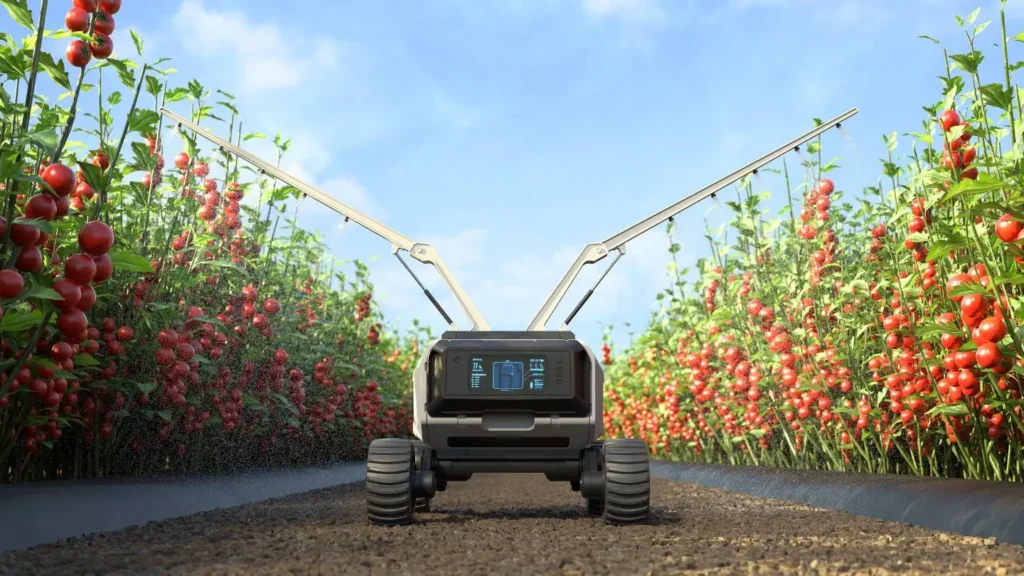

Automation in agriculture harnesses the power of AI to tackle labor shortages and enhance efficiency through advanced tools like driverless tractors and smart irrigation systems. These technologies bring a level of precision and productivity that’s hard to achieve with traditional methods.
Driverless tractors, for instance, can operate around the clock, planting and harvesting crops with pinpoint accuracy. This reduces the need for manual labor and helps address the growing issue of labor shortages in the agricultural sector.
Smart irrigation systems are another game-changer. They utilize sensors and AI algorithms to determine the exact amount of water each plant needs. This not only conserves water but also ensures that crops receive the ideal amount of hydration, leading to healthier plants and higher yields.
Precision agriculture goes even further by using AI to identify specific areas in a field that need attention, whether it’s irrigation, fertilization, or pest control.
Vertical agriculture, powered by AI, allows for the cultivation of crops in stacked layers, maximizing space and minimizing resource usage. This innovative approach significantly boosts food production while promoting sustainable farming practices.
Key challenges farmers face
As a farmer, you know that pests, soil quality, and irrigation are some of your biggest challenges. Pests can destroy nearly half of your crops, soil degradation affects yields, and inefficient irrigation wastes precious water.
You also have to battle weeds that greatly reduce plant production and increase your costs.
Pests
How can farmers effectively combat pests that devour nearly 40% of global agricultural productivity each year, costing the industry over $70 billion? The answer lies in leveraging AI to tackle this formidable challenge.
AI-driven solutions help identify and manage pests more efficiently, reducing their global impact and saving costs. By using machine learning algorithms and image recognition, farmers can detect pest infestations early, allowing for timely intervention and minimizing crop damage.
AI systems can analyze vast amounts of data from satellite imagery, drones, and sensors to predict pest outbreaks and recommend targeted treatments. This precision agriculture approach not only improves agricultural productivity but also reduces the environmental impact of pesticide use. For instance, AI can help pinpoint the exact areas needing treatment, avoiding blanket spraying and preserving beneficial insects.
Moreover, AI tools can track pest migration patterns, enabling farmers to prepare in advance and implement preventive measures. With real-time updates and predictive analytics, you can make informed decisions that protect your crops and boost yields.
Soil Quality and Irrigation
With soil degradation impacting a third of Earth’s soil and water scarcity compounded by inefficient irrigation, farmers face serious challenges in maintaining crop productivity. Poor soil quality hinders the ability to grow healthy crops, leading to significant financial losses. Adding to this, water management practices are often outdated and inefficient, resulting in wasted resources and lower yields.
You might wonder how you can tackle these issues. This is where artificial intelligence (AI) comes in. AI can analyze soil conditions in real-time, providing you with data on soil composition, moisture levels, and nutrient deficiencies. By understanding your soil’s needs, you can implement targeted management practices to enhance crop growth.
Moreover, AI-powered irrigation systems can optimize water usage by delivering precise amounts of water to your crops. These smart systems reduce waste by detecting leaks and adjusting watering schedules based on weather forecasts and soil moisture data. By using AI, you can guarantee your crops get the right amount of water they need, boosting productivity and sustainability.
In short, leveraging AI helps you make informed decisions about soil and water management, overcoming key challenges and ensuring better crop yields with minimal waste.
Weeds
While soil quality and efficient irrigation are vital, another major hurdle farmers face is the relentless battle against weeds. Weeds greatly impact agriculture by reducing crop yield and quality. With around 1800 weed species affecting plant production, you’re up against a formidable enemy.
These unwelcome plants compete directly with your crops for essential resources like water, nutrients, and sunlight, hampering their growth.
The economic losses due to weeds are staggering, amounting to about $32 billion annually. This figure highlights the severe financial hit that farmers endure, affecting the overall profitability and sustainability of agricultural operations. Weeds aren’t just an inconvenience; they’re a major economic burden that can’t be ignored.
Effective weed management is essential to maintaining high crop yields and ensuring healthy plant production. Traditional methods like manual weeding and chemical herbicides often fall short, proving to be labor-intensive, costly, and sometimes harmful to the environment.
Integrating AI technologies can offer innovative solutions to this age-old problem. By leveraging AI-driven tools, you can identify and target weeds more efficiently, optimize resource usage, and ultimately reduce economic losses. Embracing these technologies is key for modern agriculture to thrive.
How AI is transforming Agriculture
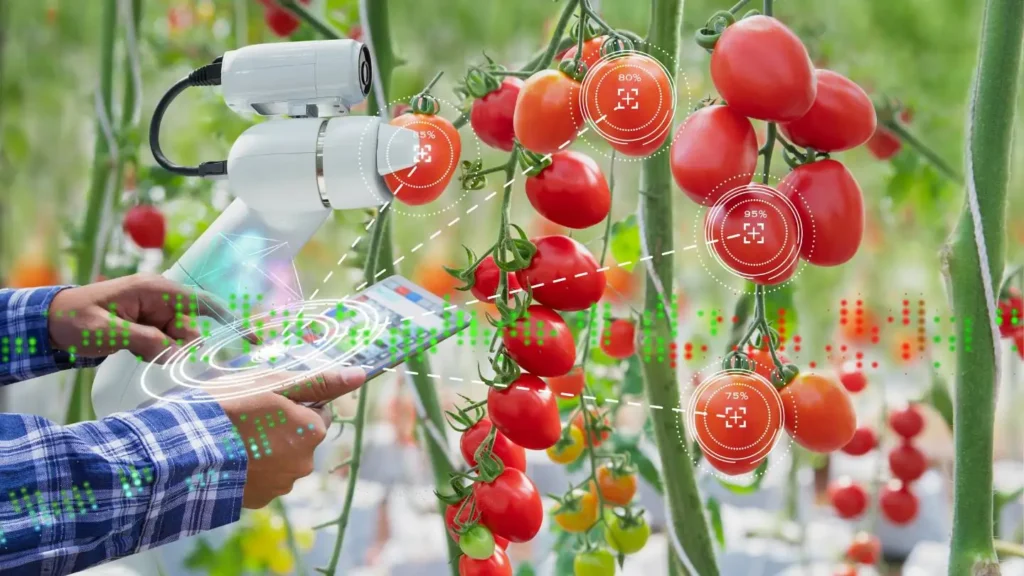

Harnessing the power of AI, agriculture is undergoing a significant transformation, boosting efficiency and sustainability like never before. With advanced technology, new management strategies are emerging that transform agricultural systems. AI tools predict weather patterns, pest attacks, and crop diseases, enabling proactive crop health management. This helps farmers tackle global challenges such as climate change and food security more effectively.
AI optimizes resource utilization, reducing waste and improving productivity. For example, precision farming uses AI to forecast weather conditions and identify crop stress early. Thermal imagery combined with AI algorithms detects pests before they cause significant damage, reducing the need for pesticides and minimizing environmental impact.
Tools like Intel’s OpenVINO enhance visual analysis in crop fields, allowing for quick issue resolution and better crop management. Small-scale farmers also benefit from AI by getting access to data-driven tools that improve decision-making and boost economic outcomes. AI empowers them to adopt sustainable practices, optimize input sourcing, and increase yields.
Challenges of artificial intelligence in agriculture
When considering AI in agriculture, you’ll face several challenges. High upfront costs and reluctance to embrace new technologies can be significant barriers.
Additionally, a lack of practical experience and the lengthy adoption process further complicate the implementation of AI solutions.
Large upfront costs
High initial costs for AI technology in agriculture can be a significant hurdle, especially for small-scale farmers. The costs involved in adopting AI tools—ranging from hardware and software to sensors and infrastructure—can be overwhelming. These expenses often require a substantial upfront investment, which can act as a barrier for small-scale farmers who might lack the necessary financial resources. For many, the thought of investing large sums without immediate returns can be challenging.
Implementing AI solutions isn’t just about the initial outlay; you also need to take into account the ongoing costs for training, maintenance, and support. These additional financial burdens can strain already limited budgets, making it even more difficult for smaller operations to take the leap into AI. However, despite these high initial costs, the potential long-term benefits—like increased efficiency, higher productivity, and reduced losses—are significant.
In the long run, the investment can pay off, but the difficulty lies in overcoming the initial financial barrier. Small-scale farmers, in particular, might find it hard to justify or secure the necessary funding, making it important to explore alternative financing options or subsidies to make AI more accessible.
Reluctance to embrace new technologies
Many farmers hesitate to adopt AI technologies due to unfamiliarity and skepticism about their benefits. You might find that the adoption barriers are significant, especially when the technology seems complex and unproven. This skepticism often stems from concerns about technological limitations and whether the tools can truly deliver on their promises.
Another major issue is infrastructure gaps. If you don’t have reliable internet access or the necessary hardware, integrating AI into your farming operations can feel like an insurmountable challenge. These gaps can make it difficult to even consider adopting new technologies, let alone fully implement them.
Data privacy is another critical concern. When using AI, there’s often a need to share substantial amounts of data. You might worry about who’s access to this information and how it’s being used. This fear of data breaches and misuse can make you reluctant to embrace AI solutions.
Lack of practical experience
You might find that a lack of practical experience with AI technologies in agriculture can greatly hinder their adoption and implementation. Farmers often struggle to integrate AI tools into their daily operations simply because they don’t have the necessary practical knowledge or skills. This gap can slow down the uptake of AI solutions, which are important for improving efficiency, productivity, and sustainability in farming practices.
To overcome this challenge, targeted training programs and workshops are important. These educational initiatives can equip farmers with the practical knowledge they need to effectively use AI technologies. By participating in these programs, farmers can develop the skills required to integrate AI into their work seamlessly. Practical, hands-on training helps demystify complex AI tools, making them more accessible and user-friendly.
Moreover, collaboration between tech providers and agricultural experts is essential. This partnership can facilitate the transfer of knowledge and practical experience, ensuring that farmers feel confident using AI tools. When tech companies and agricultural professionals work together, they can create tailored solutions that address the unique needs of the farming community.
In this collaborative environment, the gap in practical experience can be significantly reduced, paving the way for broader AI adoption in agriculture.
A lengthy technology adoption process
The lengthy process of adopting new technology often slows down the integration of AI solutions in agriculture. You might find that shifting to AI isn’t straightforward. The technology adoption process in agriculture can be time-consuming, creating barriers that delay the benefits AI promises. This sluggish pace hampers your ability to quickly leverage AI for improving yields and implementing sustainable practices.
One of the main challenges you face is overcoming these adoption barriers. The complexity of integrating AI tools can be intimidating without adequate education and support. To navigate this, you need thorough training programs that demystify AI and show you how to effectively use these technologies. Ongoing support is vital to make sure you’re not left in the dark after initial implementation.
Education plays an important role in easing the adoption process. By equipping yourself and your team with the necessary knowledge, you can make informed decisions and seamlessly shift to AI-driven practices. Support networks, including tech experts and peer communities, can further assist you in troubleshooting issues and sharing best practices.
Overcoming these barriers with the right education and support will enable you to fully capitalize on AI’s potential in agriculture.
Technological limitations
Adopting AI in agriculture often runs into roadblocks due to inadequate infrastructure and limited internet connectivity. These challenges hinder effective technology utilization, making it tough for farmers to fully leverage AI’s potential. Without a robust infrastructure, even the most advanced AI tools can’t deliver their promises, leading to inefficiencies and missed opportunities.
Another significant hurdle is digital literacy. Many farmers lack the necessary skills to operate sophisticated AI systems. This gap in knowledge prevents them from accessing valuable insights that could enhance productivity and sustainability. Bridging this obstacle is essential for maximizing the benefits of technology in agriculture.
Addressing these challenges requires robust collaborations between governments, tech companies, and agricultural stakeholders. By working together, these entities can develop and deploy infrastructure improvements and educational programs tailored to farmers’ needs. Such collaborations can also facilitate the sharing of best practices and resources, ensuring that technology in agriculture reaches its full potential.
Despite these limitations, AI holds the promise of creating sustainable and resilient agricultural systems. Overcoming the challenges of infrastructure utilization and digital literacy will pave the way for a more efficient, productive, and sustainable agricultural future.
Privacy and security issues
Exploring the terrain of AI in agriculture, it’s essential to address the pressing issues of data privacy and security head-on. As AI integrates deeper into farming, the extensive data collection required raises significant security concerns. You must be aware that unauthorized access to sensitive agricultural data by third parties is a real threat.
Protecting farmers’ proprietary information is critical, as any breach could have devastating consequences for their livelihoods and competitive edge. To safeguard this data, secure data storage solutions are of utmost importance. You should prioritize systems that guarantee encrypted data transmission and robust storage protocols. By doing so, you can prevent data breaches and maintain the trust of those using AI technologies in agriculture.
Moreover, addressing these privacy and security issues isn’t just about technology—it’s about fostering confidence among farmers. They need assurance that their data is protected and won’t be misused. By focusing on secure data storage and implementing strong preventive measures against breaches, you help create an environment where AI can thrive without compromising data privacy.
This approach is essential for the widespread adoption and success of artificial intelligence in agriculture.
The Future of AI in Agriculture
In the future, AI will redefine agriculture by continually optimizing farming practices and guaranteeing sustainability. Predictive analytics will transform crop management, enabling farmers to forecast yield outcomes accurately and make real-time adjustments. Deep learning algorithms will analyze vast amounts of data to create sustainable and resilient farming systems, ensuring the global food supply can meet increasing demands.
You’ll see AI-driven tools predicting weather patterns, pest attacks, and crop diseases with unparalleled accuracy. These insights will help you optimize resource use and minimize waste, directly contributing to more efficient farming operations. Imagine having the power to make data-driven decisions that boost productivity and safeguard environmental sustainability.
AI won’t just benefit large-scale commercial farms. Small-scale farmers will gain access to advanced tools that optimize yields and resource utilization, leveling the playing field and fostering economic development. You’ll be able to improve your standards of living while contributing to a more resilient agricultural future.
As AI continues to evolve, it will bridge the technology gap, making farming smarter and more sustainable. The future of agriculture, shaped by AI, promises enhanced productivity, reduced environmental impact, and a secure global food supply.
Your Partner for AI
As mentioned before, technology is turning farmers into precision scientists. The advent of autonomous agricultural machinery will further remove farmers from manual work and put them in the shoes of Chief-Growth-Officers making informed farming decisions.
At EasyFlow we develop artificial Intelligence and computer vision models to enable precision farming.
The Contact us today to discuss how artificial intelligence can tackle your daily farm management challenges.
Let’s talk.
Curious About The Above Solution?
Chat with Vejūnė and explore your possibilities without any commitment.


Vėjūnė Krašinskienė
Chief Operating Officer
Book a no-obligation free consultation with our expert.

